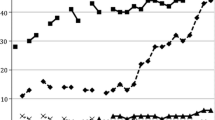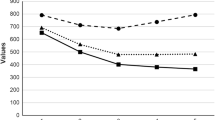Abstract
An investigation is presented of the relationship between gender and five self-reported high-risk sex behaviors: ever having had casual sex, the lifetime number of vaginal sex partners, the lifetime number of anal sex partners, having had multiple vaginal sex partners over the short term, and having had multiple anal sex partners over the short term. The analysis was guided by a conceptual model that emphasized the constraints and opportunities for high-risk sex behavior that arise from an individual's structural position and cultural context. Gender differences in high-risk sex behaviors were predicted to be due to differences in men's and women's family roles, work roles, religious behaviors, and past sex experience. In addition, the effects of certain sociocultural factors on the high-risk sex behaviors were expected to be dependent on an individual's gender. The hypotheses were evaluated using national data from the United States on self-reported sex behaviors for men ages 20 to 39 years old and women ages 20 to 37 years old. Data analyses were conducted using ordinary least-squares regression and logistic regression. Findings provided mixed support for the predictions. Gender was not significantly related to short-term, self-reported high-risk sex behaviors once social and cultural factors were included in the statistical models. But it continued to predict lifetime behaviors. Several variables, including race, age, age at first sex, and marital status, had gender-specific effects on the self-reported high-risk sex behaviors. The study demonstrates how the effects of structural and cultural factors on sex behavior differ for men and women.
Similar content being viewed by others
REFERENCES
Baldwin, J., and Baldwin, J. (1988). Factors affecting AIDS-related sexual risk-taking behavior among college students. J. Sex Res. 25: 181-196.
Batson, C., Schoenrade, P., and Ventis, W. (1993). Religion and the Individual: A Social-Psychological Perspective, Oxford University Press, New York.
Benson, P., Donahue, M., and Erickson, J. (1989). Adolescence and religion: A review of the literature from 1970-1986. Res. Soc. Sci. Study Religion 1: 153-181.
Billy, J., Tanfer, K., Grady, W., and Klepinger, D. (1993). The sexual behavior of men in the United States. Family Plan. Perspect. 25: 52-60.
Bishop, Y., Fienberg, S., and Holland, P. (1975). Discrete Multivariate Analysis: Theory and Practice, MIT Press, Cambridge, MA.
Blumstein, P., and Schwartz, P. (1983). American Couples: Money, Work, Sex, Morrow, New York.
Brines, J. (1994). Economic dependency, gender, and division of labor at home. Am. J. Sociol. 100: 652-660.
Byers, E., and Heinlein, L. (1989). Predicting initiations and refusals of sexual activities in married and cohabiting heterosexual couples. J. Sex Res. 26: 210-231.
Catania, J., Coates, T., Stall, R., Turner, H., Peterson, J., Hearst, N., Dolcini, M., Hudes, E., Gagnon, J., Wiley, J., and Groves, R. (1992). Prevalence of AIDS-related risk factors and condom use in the United States. Science 258: 1101-1106.
Clark, R. (1990). The impact of AIDS on gender differences in willingness to engage in casual sex. J. Appl. Soc. Psychol. 20: 771-782.
Clement, U. (1989). Profile analysis as a method of comparing intergenerational differences in sexual behavior. Arch. Sex. Behav. 18: 229-237.
Cochran, S., and Peplau, L. (1991). Sexual risk reduction behaviors among young heterosexual adults. Soc. Sci. Med. 33: 25-36.
Cohen, L. L., and Shotland, R. L. (1996). Timing of first sexual intercourse in a relationship: Expectations, experiences, and perceptions of other. J. Sex Res. 33: 291-299.
Cornwall, M. (1988). The influence of three agents of religious socialization: Family, church, and peers. In Thomas, D. (ed.), The Religion and Family Connection: Social Science Perspectives, Religious Studies Center, Brigham Young University, Provo, UT, pp. 207-231.
Darabi, K. (1987). Childbearing Among Hispanics in the United States, Greenwood Press, New York.
Darnton, J. (1994). The extent of monogamy in Britain. New York Times Feb. 1: B8.
Davidson, J. K., Darling, C. A., and Norton, L. (1995). Religiosity and the sexuality of women: Sexual behavior and sexual satisfaction revisited. J. Sex Res. 32: 235-243.
Davis, J., and Smith, T. (1991). General Social Surveys, 1972-1991: Cumulative Codebook, National Opinion Research Center, Chicago.
Forrest, J., and Singh, S. (1990). The sexual and reproductive behavior of American women. Family Plan. Perspect. 22: 206-214.
Gerrard, M., Breda, C., and Gibbons, F. (1990). Gender effects in couples' sexual decision making and contraceptive use. J. Appl. Soc. Psychol. 20: 449-464.
Gagnon, J., and Simon, W. (1973). Sexual Conduct, Aldine, Chicago.
Glass, S., and Wright, T. (1992). Justifications for extramarital relationships: The association between attitudes, behaviors, and gender. J. Sex Res. 29: 361-387.
Grauerholz, E., and Serpe, R. (1985). Initiation and response: The dynamics of sexual interaction. Sex Roles 12: 1041-1059.
Hanushek, E., and Jackson, J. (1977). Statistical Methods for Social Scientists, Academic Press, New York.
Hendrick, S., Hendrick, C., Slapion-Foote, H., and Foote, F. (1985). Gender differences in sexual attitudes. J. Pers. Soc. Psychol. 48: 1630-1642.
Herold, E., and Mewhinney, D. K. (1993). Gender differences in casual sex and AIDS prevention: A survey of dating bars. J. Sex Res. 30: 36-42.
Jasso, G. (1985). Marital coital frequency and the passage of time: Estimating the separate effects of spouses' ages and marital duration, birth and marriage cohorts, and period influences. Am. Sociol. Rev. 50: 224-241.
Keller, J., Elliott, S., and Gunberg, E. (1982). Premarital sexual intercourse among single college students: A discriminant analysis. Sex Roles 8: 21-32.
Kost, K., and Forrest, J. (1992). American women's sexual behavior and exposure to risk of sexually transmitted diseases. Family Plan. Perspect. 24: 244-254.
Laumann, E., Gagnon, J., Michael, R., and Michaels, S. (1994). The Social Organization of Sexuality: Sexual Practices in the United States, University of Chicago Press, Chicago.
Leigh, J. P. (1983). Direct and indirect effects of education on health. Soc. Sci. Med. 17: 227-234.
McCormick, N., Brannigan, G., and LaPlante, M. (1984). Social desirability in the bedroom: Role of approval motivation in sexual relationships. Sex Roles 11: 303-314.
Miller, A., and Hoffmann, J. (1995). Risk and religion: An explanation of gender differences in religiosity. J. Sci. Study Religion 34: 63-75.
O'Sullivan, L., and Byers, E. (1993). Eroding stereotypes: College women's attempts to influence reluctant male sexual partners. J. Sex Res. 30: 270-282.
Peplau, L., Rubin, Z., and Hill, C. (1977). Sexual intimacy in dating relationships. J. Soc. Issues 33:86-109.
Phillis, D., and Gromko, M. (1985). Sex differences in sexual activity: Reality or illusion? J. Sex Res. 21: 437-443.
Reiss, I. (1986a). A sociological journey into sexuality. J. Marriage Family 48: 233-242.
Reiss, I. (1986b). Journey into Sexuality: An Exploratory Voyage, Prentice-Hall, Englewood Cliffs, NJ.
Ross, C., and Van Willigen, M. (1997). Education and the subjective quality of life. J. Health Soc. Behav. 38: 275-297.
Schwartz, P., and Rutter, V. (1998). The Gender of Sexuality, Pine Forge, Thousand Oaks, CA.
Simon, W., and Gagnon, J. (1984). Sexual scripts: Permanence and change. Society 22: 53-60.
Smith, T. (1992). Discrepancies between men and women in reporting number of sexual partners: A summary from four countries. Soc. Biol. 39: 203-211.
Smith, T. (1994). Attitudes toward sexual permissiveness: Trends, correlates, and behavioral connections. In Rossi, A. (ed.), Sexuality Across the Life Course, University of Chicago Press, Chicago, pp. 63-97.
Sprecher, S. (1989). Premarital sexual standards for different categories of individuals. J. Sex Res. 26: 232-248.
Tanfer, K., and Cubbins, L. (1992). Coital frequency among single women: Normative constraints and situational opportunities. J. Sex Res. 29: 221-250.
Tanfer, K., Cubbins, L., and Billy, J. (1995). Gender, race, class, and sexually transmitted diseases. Family Plan. Perspect. 27: 196-102.
Taris, T. W., and Semin, G. R. (1997). Gender as a moderator of the effects of the love motive and relational context on sexual experience. Arch. Sex. Behav. 26: 159-180.
Trussell, J., and Westoff, C. (1980). Contraceptive practice and trends in coital frequency. Family Plan. Perspect. 12: 246-249.
Tucker, M. B., and Mitchell-Kernan, C. (1995). The Decline in Marriage Among African Americans: Causes, Consequences, and Policy Implications, Russell Sage, New York.
Udry, J., Deven, F., and Coleman, S. (1982). A cross-national comparison of the relative influence of male and female age on the frequency of marital intercourse. J. Biosoc. Sci. 14: 1-6.
U.S. Department of Health and Human Services (1991). Healthy People 2000: National Health Promotion and Disease Prevention Objectives, DHHS Publication No. (PHS) 91-50212, U.S. Government Printing Office, Washington, DC.
U.S. Department of Health and Human Services (1997). Sexually Transmitted Disease Surveillance, 1996, Division of STD Prevention, Public Health Service, Centers for Disease Control, Atlanta, GA.
U.S. Women's Bureau (1993). Facts on Working Women, Report No. 93-2, U.S. Government Printing Office, Washington, DC.
Verbrugge, L. M. (1989). The twain meet: Empirical evidence of sex differences in health and mortality. J. Health Soc. Behav. 30: 282-304.
Weinberg, M., and Williams, C. (1988). Black sexuality:Atest of two theories. J. Sex Res. 25: 197-218.
Wiederman, M. W. (1997). The truth must be in here somewhere: Examining the gender discrepancy in self-reported lifetime number of sex partners. J. Sex Res. 34: 375-386.
Wilson, S., and Medora, N. (1990). Gender comparisons of college students' attitudes toward sexual behavior. Adolescence 25: 615-627.
Wilson, W. J. (1978). The Declining Signficance of Race, University of Chicago Press, Chicago.
Author information
Authors and Affiliations
Rights and permissions
About this article
Cite this article
Cubbins, L.A., Tanfer, K. The Influence of Gender on Sex: A Study of Men's and Women's Self-Reported High-Risk Sex Behavior. Arch Sex Behav 29, 229–257 (2000). https://doi.org/10.1023/A:1001963413640
Issue Date:
DOI: https://doi.org/10.1023/A:1001963413640




